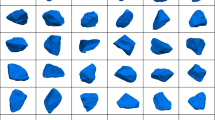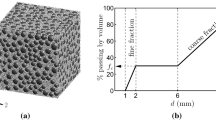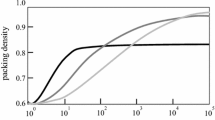Abstract
In recent years, binary mixtures have been the subject of numerous experimental and numerical studies. However, few attempts have been made on investigating the effect of fines content (fc) on the non-associated plasticity of binary mixtures, which is significant for constitutive modelling of such material. Thanks to 2D DEM simulations, this study aims to provide an understanding of how fc affects the non-associated character of the flow rule and the resulting material instability in binary mixtures. For under-filled materials (where coarse grains constitute most of the load-bearing skeleton), fine grains help to stabilize the granular assembly (1) by limiting macroscopic plastic deformations, which results in strain hardening, and (2) by reducing contractive microstructure reorganizations, which reduces the gap between the associated and non-associated flow rule directions. Fines content influences the plastic flow direction but has no influence on normal direction of yield surface. Eventually, perspectives on mesoscale mechanisms are given to highlight the role of fine grains in the geometrical and mechanical properties of granular materials.


















Similar content being viewed by others
Notes
Note that “fine” is used throughout the paper as opposed to “coarse”. It does not refer to particles smaller than 80 µm.
References
Ahmadi M, Shire T, Mehdizadeh A, Disfani M (2020) DEM modelling to assess internal stability of gap-graded assemblies of spherical particles under various relative densities, fine contents and gap ratios. Comput Geotech 126:103710
Anandarajah A (2008) Multi-mechanism anisotropic model for granular materials. Int J Plast 24:804–846
Bardet JP (1994) Numerical simulations of the incremental responses of idealized granular materials. Int J Plast 10:879–908
Bigoni D, Hueckel T (1991) Uniqueness and localization—I. Associative and non-associative elastoplasticity. Int J Solids Struct 28:197–213
Cambou B, Dubujet P, Nouguier-Lehon C (2004) Anisotropy in granular materials at different scales. Mech Mater 36:1185–1194
Calvetti F, Viggiani G, Tamagnini C (2003) A numerical investigation of the incremental behavior of granular soils. Riv Geotech 3:11–29
Cao X, Zhu Y, Gong J (2021) Effect of the intermediate principal stress on the mechanical responses of binary granular mixtures with different fines contents. Granul Matter 23:1–19
Chang CS, Meidani M, Deng Y (2017) A compression model for sand–silt mixtures based on the concept of active and inactive voids. Acta Geotech 12:1301–1317
Chen GX, Wu Q, Sun T, Zhao K, Zhou EQ, Xu LY, Zhou YG (2021) Cyclic behaviors of saturated sand-gravel mixtures under undrained cyclic triaxial loading. J Earthq Eng 25:756–789
Cundall PA, Strack OD (1979) A discrete numerical model for granular assemblies. Géotechnique 29:47–65
Dantu P (1968) Etude statistique des forces intergranulaires dans un milieu pulvérulent. Géotechnique 18:50–55
Darve F, Laouafa F (2000) Instabilities in granular materials and application to landslides. Mech Cohes-frict Mater: An Int J Exp, Model Comput Mater Struct 5:627–652
Darve F, Servant G, Laouafa F, Khoa HDV (2004) Failure in geomaterials: continuous and discrete analyses. Comput Methods Appl Mech Eng 193:3057–3085
De Frias LR, Silfwerbrand J, Jelagin D, Birgisson B (2016) Force transmission and soil fabric of binary granular mixtures. Géotechnique 66:578–583
Dong H, Peng B, Gao QF, Hu Y, Jiang X (2021) Study of hidden factors affecting the mechanical behavior of soil–rock mixtures based on abstraction idea. Acta Geotech 16:595–611
Drescher A, De Jong GDJ (1972) Photoelastic verification of a mechanical model for the flow of a granular material. J Mech Phys Solids 20:37–340
Fu P, Dafalias YF (2011) Study of anisotropic shear strength of granular materials using DEM simulation. Int J Numer Anal Meth Geomech 35:1098–1126
Gong J, Liu J (2017) Mechanical transitional behavior of binary mixtures via DEM: effect of differences in contact-type friction coefficients. Comput Geotech 85:1–14
Gong J, Wang X, Li L, Nie Z (2019) DEM study of the effect of fines content on the small-strain stiffness of gap-graded soils. Comput Geotech 112:35–40
Gudehus G (1979) A comparison of some constitutive laws for soils under radially symmetric loading and unloading. In Proc. Conf. on Num. Meth. in Geomech (pp. 1309–1324)
Guo N, Zhao J (2013) The signature of shear-induced anisotropy in granular media. Comput Geotech 47:1–15
Hill R (1958) A general theory of uniqueness and stability in elastic-plastic solids. J Mech Phys Solids 6:236–249
Hoque E, Tatsuoka F (1998) Anisotropy in elastic deformation of granular materials. Soils Found 38:163–179
Lashkari A (2016) Prediction of flow liquefaction instability of clean and silty sands. Acta Geotech 11:987–1014
Li XS, Dafalias YF (2002) Constitutive modeling of inherently anisotropic sand behavior. J Geotech Geoenviron Eng 128:868–880
Lobo-Guerrero S, Vallejo LE (2006) Discrete element method analysis of railtrack ballast degradation during cyclic loading. Granular Matter 8:195
Majmudar TS, Behringer RP (2005) Contact force measurements and stress-induced anisotropy in granular materials. Nature 435:1079–1082
Minh NH, Cheng YP (2013) A DEM investigation of the effect of grain-size distribution on one-dimensional compression. Géotechnique 63:4–53
Miura K, Maeda K, Furukawa M, Toki S (1997) Physical characteristics of sands with different primary properties. Soils Found 37:53–64
Nemat-Nasser S (2000) A micromechanically-based constitutive model for frictional deformation of granular materials. J Mech Phys Solids 48:1541–1563
Ng TT, Zhou W, Chang XL (2017) Effect of particle shape and fine content on the behavior of binary mixture. J Eng Mech 143:C4016008
Nicot F, Darve F (2006) Micro-mechanical investigation of material instability in granular assemblies. Int J Solids Struct 43:3569–3595
Nicot F, Hadda N, Bourrier F, Sibille L, Wan R, Darve F (2012) Inertia effects as a possible missing link between micro and macro second-order work in granular media. Int J Solids Struct 49:1252–1258
Oda M (1982) Fabric tensor for discontinuous geological materials. Soils Found 22:6–108
Peters JF, Muthuswamy M, Wibowo J, Tordesillas A (2005) Characterization of force chains in granular material. Phys Rev E 72:041307
Phan QT, Bui HH, Nguyen GD, Bouazza A (2021) Effect of particle rolling resistance on drained and undrained behaviour of silty sand. Acta Geotechnica 16:2657
Porcino DD, Diano V, Triantafyllidis T, Wichtmann T (2020) Predicting undrained static response of sand with non-plastic fines in terms of equivalent granular state parameter. Acta Geotech 15:867–882
Pucilowski S, Tordesillas A (2020) Rattler wedging and force chain buckling: metastable attractor dynamics of local grain rearrangements underlie globally bistable shear banding regime. Granul Matter 22:1–7
Radjai F, Wolf DE, Jean M, Moreau JJ (1998) Bimodal character of stress transmission in granular packings. Phys Rev Lett 80:61
Rahman MM, Lo SR, Baki MAL (2011) Equivalent granular state parameter and undrained behaviour of sand–fines mixtures. Acta Geotech 6:183–194
Rothenburg L, Bathurst RJ (1989) Analytical study of induced anisotropy in idealized granular materials. Geotechnique 39:601–614
Shi XS, Liu K, Yin J (2021) Analysis of mobilized stress ratio of gap-graded granular materials in direct shear state considering coarse fraction effect. Acta Geotechnica 16:1801
Shi XS, Zhao J, Gao Y (2021) A homogenization-based state-dependent model for gap-graded granular materials with fine-dominated structure. Int J Numer Anal Meth Geomech. https://doi.org/10.1002/nag.3189
Shi XS, Zhao J, Yin J, Yu Z (2019) An elastoplastic model for gap-graded soils based on homogenization theory. Int J Solids Struct 163:1–14
Shire T, O’Sullivan C, Hanley KJ, Fannin RJ (2014) Fabric and effective stress distribution in internally unstable soils. J Geotech Geoenviron Eng 140:04014072
Shire T, O’sullivan C, Hanley KJ (2016) The influence of fines content and size-ratio on the micro-scale properties of dense bimodal materials. Granul Matter 18:52
Sibille L, Nicot F, Donzé FV, Darve F (2009) Analysis of failure occurrence from direct simulations. Eur J Environ Civ Eng 13:187–201
Šmilauer V et al. (2015) Yade Documentation 2nd ed. The Yade Project. 10.5281/zenodo.34073
Thevanayagam S (2007) Intergrain contact density indices for granular mixes—I: Framework. Earthq Eng Eng Vib 6(2):123
Thevanayagam S, Shenthan T, Mohan S, Liang J (2002) Undrained fragility of clean sands, silty sands, and sandy silts. J Geotech Geoenviron Eng 128:849–859
Tordesillas A (2007) Force chain buckling, unjamming transitions and shear banding in dense granular assemblies. Phil Mag 87:4987–5016
Vallejo LE (2001) Interpretation of the limits in shear strength in binary granular mixtures. Can Geotech J 38:1097–1104
Wan R, Pinheiro M (2014) On the validity of the flow rule postulate for geomaterials. Int J Numer Anal Meth Geomech 38:863–880
Wang T, Liu S, Wautier A, Nicot F (2021) An updated skeleton void ratio for gravelly sand mixtures considering the effect of grain size distribution. Can Geotech J. https://doi.org/10.1139/cgj-2020-0570
Wautier A, Bonelli S, Nicot F (2018) Micro-inertia origin of instabilities in granular materials. Int J Numer Anal Meth Geomech 42:1037–1056
Wautier A, Bonelli S, Nicot F (2019) Rattlers’ contribution to granular plasticity and mechanical stability. Int J Plast 112:172–193
Yamamuro JA, Lade PV (1998) Steady-state concepts and static liquefaction of silty sands. J Geotech Geoenviron Eng 124:868–877
Yang J, Luo XD (2018) The critical state friction angle of granular materials: does it depend on grading? Acta Geotech 13:535–547
Yang J, Wei LM (2012) Collapse of loose sand with the addition of fines: the role of particle shape. Géotechnique 62:1111–1125
Yin ZY, Huang HW, Hicher PY (2016) Elastoplastic modeling of sand–silt mixtures. Soils Found 56:520–532
Zhou W, Wu W, Ma G, Ng TT, Chang X (2018) Undrained behavior of binary granular mixtures with different fines contents. Powder Technol 340:139–153
Acknowledgements
The authors express their sincere thanks to the International Research Network GeoMech (IRN CNRS) for promoting positive and convivial interactions among researchers. The first author also would like to appreciate the financial support of the China Scholarship Council (CSC) (Grant No. 201906710002) for his joint research at INRAE, Grenoble Alpes University, France.
Author information
Authors and Affiliations
Corresponding author
Additional information
Publisher's Note
Springer Nature remains neutral with regard to jurisdictional claims in published maps and institutional affiliations.
Rights and permissions
About this article
Cite this article
Wang, T., Wautier, A., Liu, S. et al. How fines content affects granular plasticity of under-filled binary mixtures. Acta Geotech. 17, 2449–2463 (2022). https://doi.org/10.1007/s11440-021-01430-3
Received:
Accepted:
Published:
Issue Date:
DOI: https://doi.org/10.1007/s11440-021-01430-3




